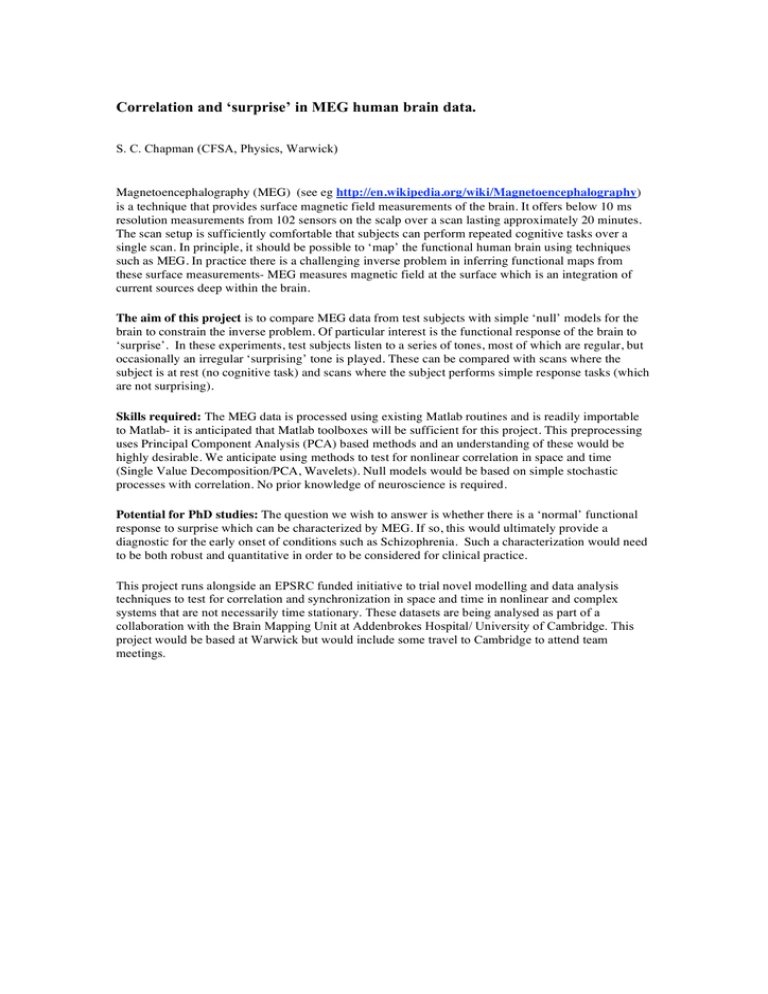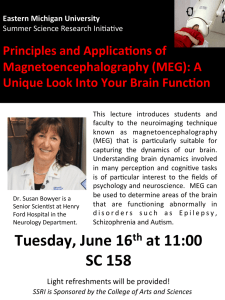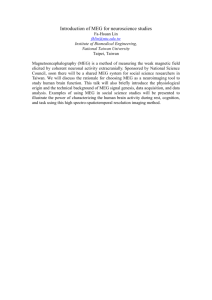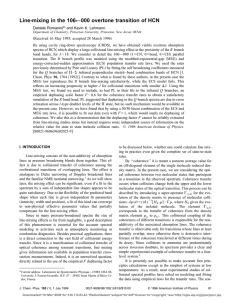Correlation and ‘surprise’ in MEG human brain data.
advertisement

Correlation and ‘surprise’ in MEG human brain data. S. C. Chapman (CFSA, Physics, Warwick) Magnetoencephalography (MEG) (see eg http://en.wikipedia.org/wiki/Magnetoencephalography) is a technique that provides surface magnetic field measurements of the brain. It offers below 10 ms resolution measurements from 102 sensors on the scalp over a scan lasting approximately 20 minutes. The scan setup is sufficiently comfortable that subjects can perform repeated cognitive tasks over a single scan. In principle, it should be possible to ‘map’ the functional human brain using techniques such as MEG. In practice there is a challenging inverse problem in inferring functional maps from these surface measurements- MEG measures magnetic field at the surface which is an integration of current sources deep within the brain. The aim of this project is to compare MEG data from test subjects with simple ‘null’ models for the brain to constrain the inverse problem. Of particular interest is the functional response of the brain to ‘surprise’. In these experiments, test subjects listen to a series of tones, most of which are regular, but occasionally an irregular ‘surprising’ tone is played. These can be compared with scans where the subject is at rest (no cognitive task) and scans where the subject performs simple response tasks (which are not surprising). Skills required: The MEG data is processed using existing Matlab routines and is readily importable to Matlab- it is anticipated that Matlab toolboxes will be sufficient for this project. This preprocessing uses Principal Component Analysis (PCA) based methods and an understanding of these would be highly desirable. We anticipate using methods to test for nonlinear correlation in space and time (Single Value Decomposition/PCA, Wavelets). Null models would be based on simple stochastic processes with correlation. No prior knowledge of neuroscience is required. Potential for PhD studies: The question we wish to answer is whether there is a ‘normal’ functional response to surprise which can be characterized by MEG. If so, this would ultimately provide a diagnostic for the early onset of conditions such as Schizophrenia. Such a characterization would need to be both robust and quantitative in order to be considered for clinical practice. This project runs alongside an EPSRC funded initiative to trial novel modelling and data analysis techniques to test for correlation and synchronization in space and time in nonlinear and complex systems that are not necessarily time stationary. These datasets are being analysed as part of a collaboration with the Brain Mapping Unit at Addenbrokes Hospital/ University of Cambridge. This project would be based at Warwick but would include some travel to Cambridge to attend team meetings.






